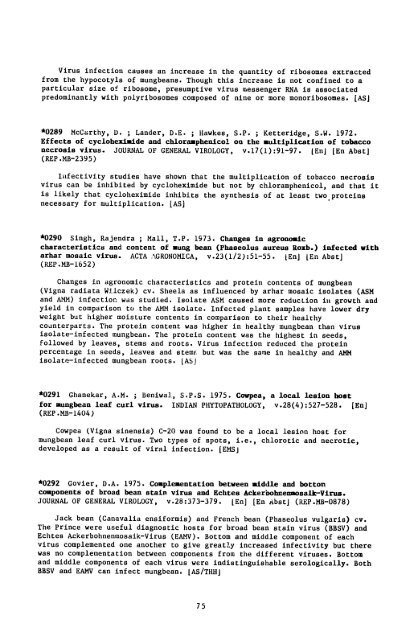PNABD246.pdf
PNABD246.pdf
PNABD246.pdf
You also want an ePaper? Increase the reach of your titles
YUMPU automatically turns print PDFs into web optimized ePapers that Google loves.
Virus infection causes an increase in the quantity of ribosomes extracted<br />
from the hypocotyls of mungbeans. Though this increase is not confined to a<br />
particular size of ribosome, presumptive virus messenger RNA is associated<br />
predominantly with polyribosomes composed of nine or more monoribosomes. [AS]<br />
*0289 McCarthy, D. ; Lander, D.E. ; Hawkes, S.P. ; Ketteridge, S.W. 1972.<br />
Effects of cycloheximide and chloramphenlcol on the multiplication of tobacco<br />
necrosis virus. JOURNAL OF GENERAL VIROLOGY, v.17(l):91-97. [EnJ [En Abstj<br />
(REP.MB-2395)<br />
Infectivity studies have shown that the multiplication of tobacco necrosis<br />
virus can be inhibited by cycloheximide but not by chloramphenicol, and that it<br />
is likely that cycloheximide inhibits the synthesis of at least two.proteins<br />
necessary for multiplication. [AS]<br />
*0290 Singh, Rajendra ; Mall, T.P. 1973. Changes in agronomic<br />
characteristics and content of aung bean (Phaseolus aureus Roxb.) infected with<br />
arhar mosaic virus. ACTA AGRONOMICA, v.23(1/2):51-55. [En] [En AbstJ<br />
(REP.MB-1652)<br />
Changes in agronomic characteristics and protein contents of mungbean<br />
(Vigna radiata Wilczek) cv. Sheela as influenced by arhar mosaic isolates (ASM<br />
and AMM) infection was studied. Isolate ASM caused more reduction in growth and<br />
yield in comparison to the AMM isolate. Infected plant samples have lower dry<br />
weight but higher moisture contents in comparison to their healthy<br />
counterparts. The protein content was higher in healthy mungbean than virus<br />
isolate-infected mungbean. The protein content was the highest in seeds,<br />
followed by leaves, stems and roots. Virus infection reduced the protein<br />
percentage in seeds, leaves and stemF. but was the same in healthy and AMM<br />
isolate-infected mungbean roots. [ASJ<br />
*0291 Ghanekar, A.M. ; Beniwa., S.P.S. 1975. Covpea, a local lesion host<br />
for mungbean leaf curl virus. INDIAN PHYTOPATHOLOGY, v.28(4):527-528. [En]<br />
(REP.MB-1404)<br />
Cowpea (Vigna sinensis) C-20 was found to be a local lesion host for<br />
mungbean leaf curl virus. Two types of spots, i.e., chlorotic and necrotic,<br />
developed as a result of viral infection. [EMSJ<br />
*0292 Govier, D.A. 1975. Complementation between middle and bottom<br />
components of broad bean stain virus and Echtes Ackerbohnenosalk-Virus.<br />
JOURNAL OF GENERAL VIROLOGY, v.28:373-379. [En] [En AbstJ (REP.MB-0878)<br />
Jack bean (Canavalia ensiformis) and French bean (Phaseolus vulgaris) cv.<br />
The Prince were useful diagnostic hosts for broad bean stain virus (BBSV) and<br />
Echtes Ackerbohnenmosaik-Virus (EAMV). Bottom and middle component of each<br />
virus complemented one another to give greatly increased infectivity but there<br />
was no complementation between components from the different viruses. Bottom<br />
and middle components of each virus were indistinguishable serologically. Both<br />
BBSV and EAMV can infect mungbean. IAS/THHJ<br />
75

















